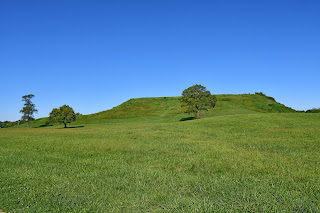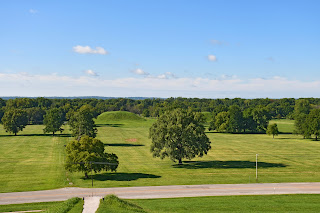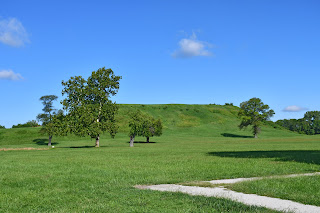Day 5: Saint Louis and Kansas City
We started our day by returning to the Illinois side of Saint Louis to visit the Cahokia Mounds. The weather was beautiful, and we saw many joggers running around, indeed, even up and down the main mound while sweating profusely. The layout of the area reminded me a lot of the layout of typical pre-Columbian Mesoamerican city centres, with their ceremonial squares and surrounding pyramids. It seems almost indubitable to me that much cultural exchange, or an evolution from a common cultural substrate, must have happened to result in such similar city planning. At some point, I’ll have to do some research on how much has been written about this already.
The erection of the Cahokia Mounds began in the ninth
century by a culture whose history is largely lost to us. The Cahokia Tribe
after whom they are named only migrated to the area after this grand
civilisation had fallen. Estimates of the city’s peak population range from
6,000 to 40,000, the higher of which would – as some historians have pointed
out – make the city larger than any subsequent city in the US until being
surpassed in the 1780s by Philadelphia.
After walking about the site for some time, we made a quick
stop by Woodhenge, an ancient astronomical structure built by the people of
Cahokia. Obviously, the wood did not last for those many hundreds of years but
was re-erected in the place where archaeological digs revealed it had once
stood. While at Woodhenge, we were approached by an exhausted-looking dog. We
made sure not to touch it despite its friendliness and the fact that it had a
collar. Luckily, another car pulled up and the lady in it – a Saint Louis local
– gave the dog food and a bowl that we filled with water. She said she would
take it to the local police station, and we left feeling reassured that the dog
would be cared for.
The same position, a different view: Fox Mound
The next stop on our journey was the Saint Louis Art Museum.
The guard who checked our bags seemed convinced that as a responsible young
woman, Kelly would keep me – a clearly wayward man – from taking pictures with
flash. Both of us were surprised at the vastness of the collection, and
especially the number of pre-Columbian
artefacts from across the Americas. We walked over to the city to have ramen
for lunch, buying a local Saint Louis specialty – a gooey butter cake – for
dessert. Well, at least we attempted to. The closest thing we could find to
where we were was a gooey butter cake cookie, which left us feeling very
ambivalent about whether we had achieved our goal of trying the food or not.
Our journey
then took us to Kansas City. Being in a formerly French part of the States, I
put on some topical music while I was driving – Louis Moreau Gottschalk. We
also finished listening to my Antonín Dvořák play-list, since the composer
spent some time in the Midwest with the local Czech community.
Kansas City
surprised us in many ways. Firstly, we realised that none of its major sights
are in Kansas but Missouri. Secondly, its centre is strangely empty for a city
of its size. Thirdly, its World War I Museum and Memorial was apparently so big
and impressive that it was designated by congress as the country’s official
museum of WWI. Kelly and I strolled around the museum and memorial briefly,
after which we made a brief stop downtown to take a look at the Kaufmann Centre
for the Performing Arts and buy dinner. My impression of Kansas City was that
despite being larger than Saint Louis, it seemed somewhat less cosmopolitan and
a little more suburban.
Our journey
today was 334 miles, with the total standing at 1662.











.jpg)












































Comments
Post a Comment